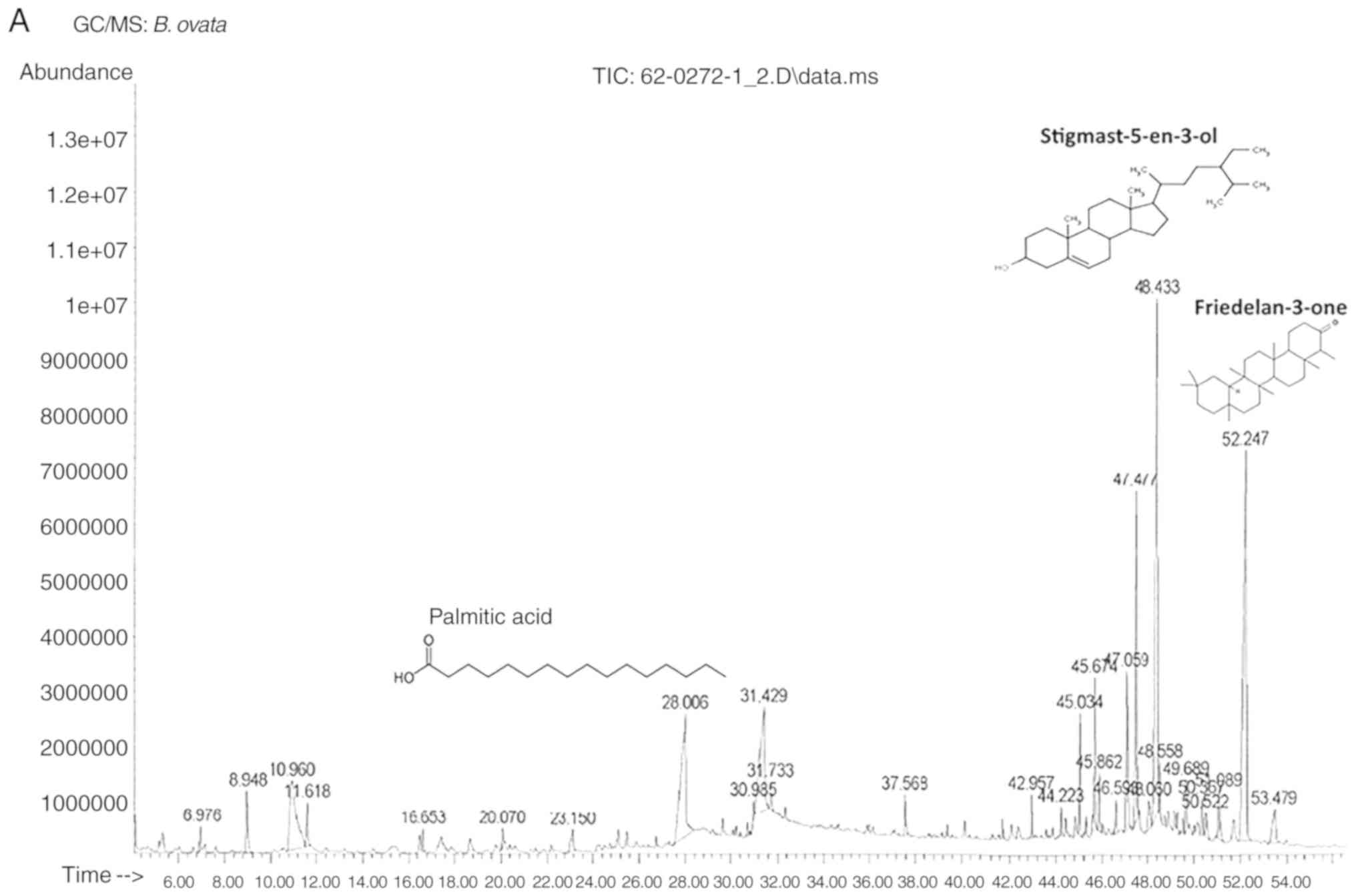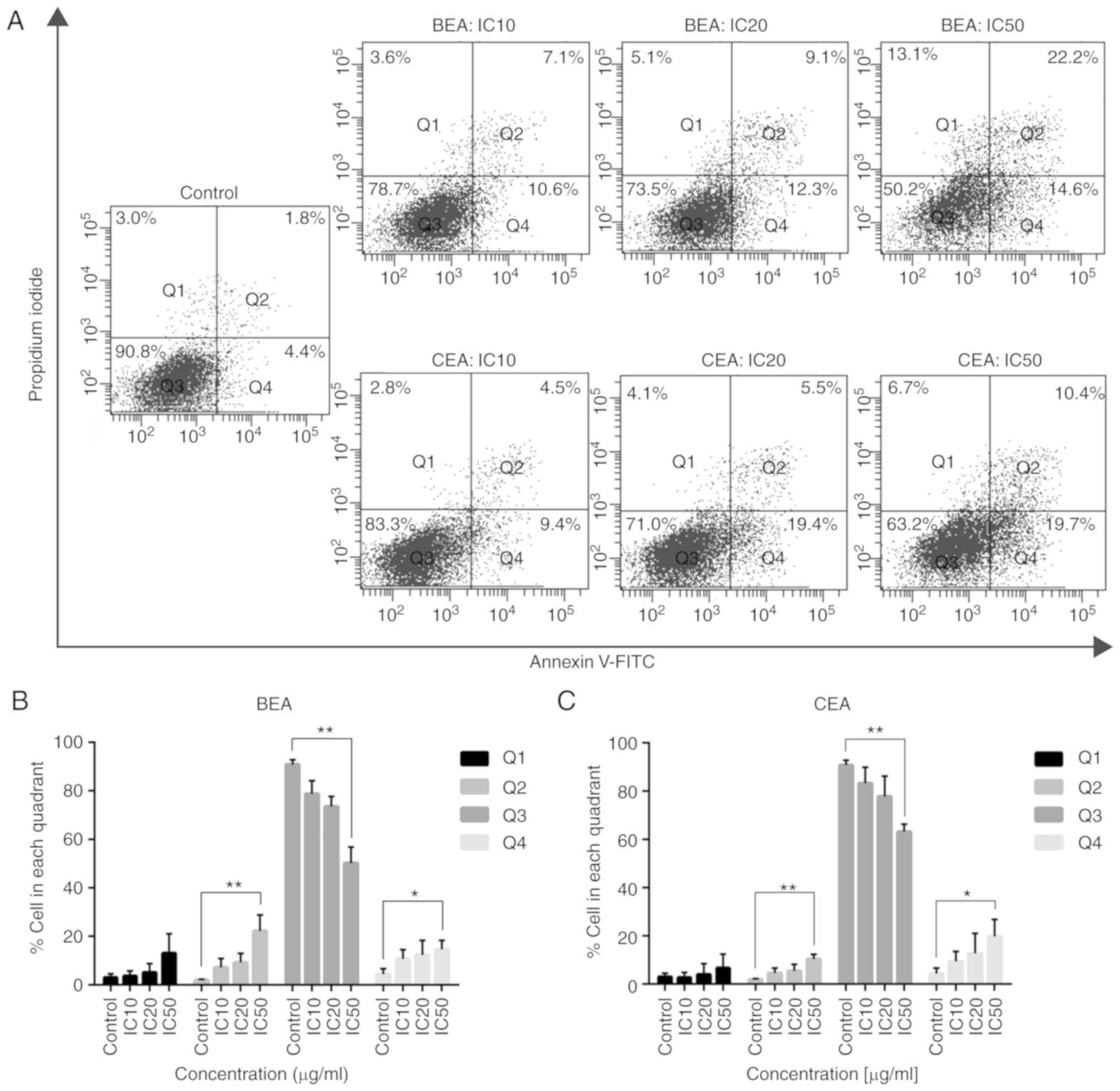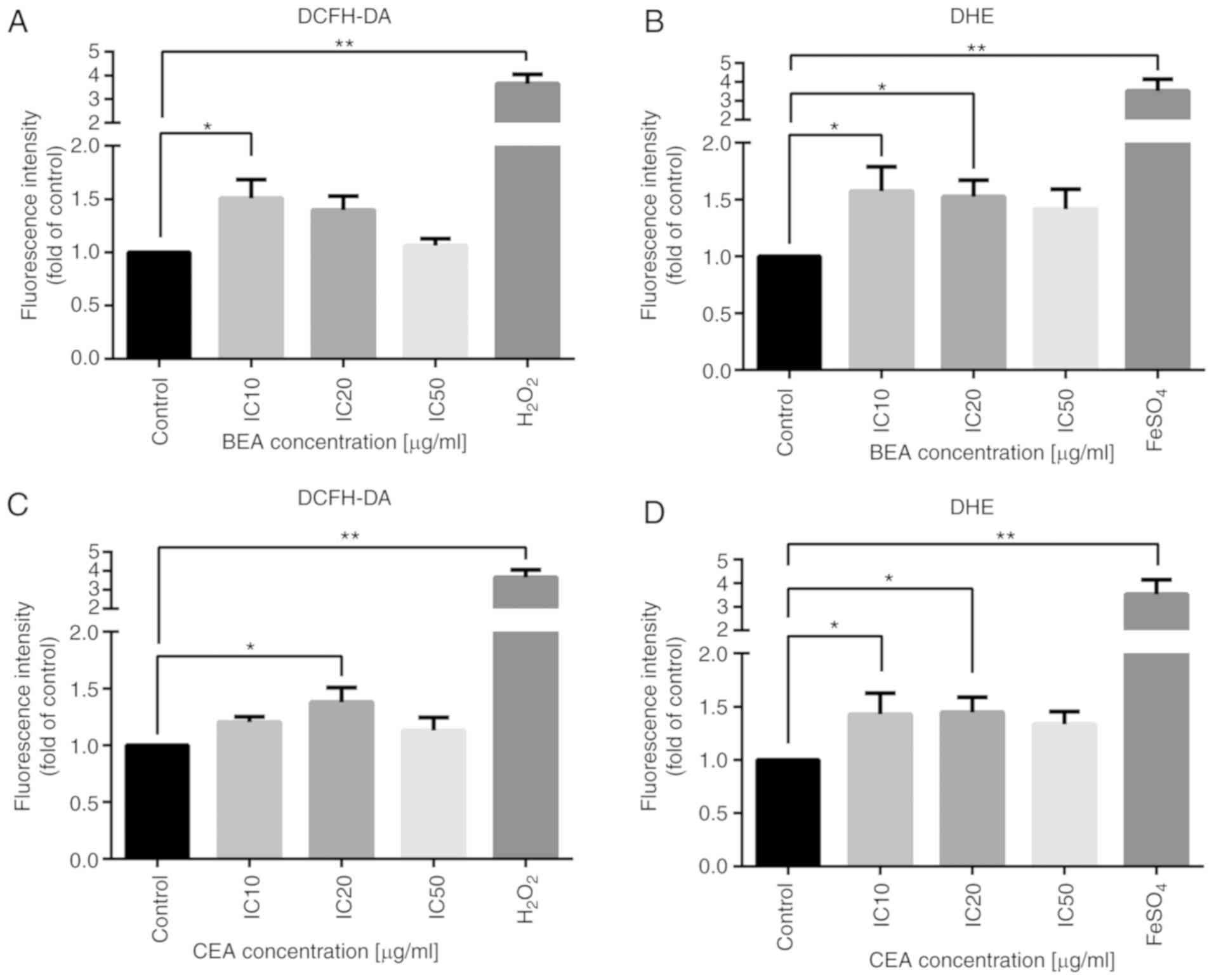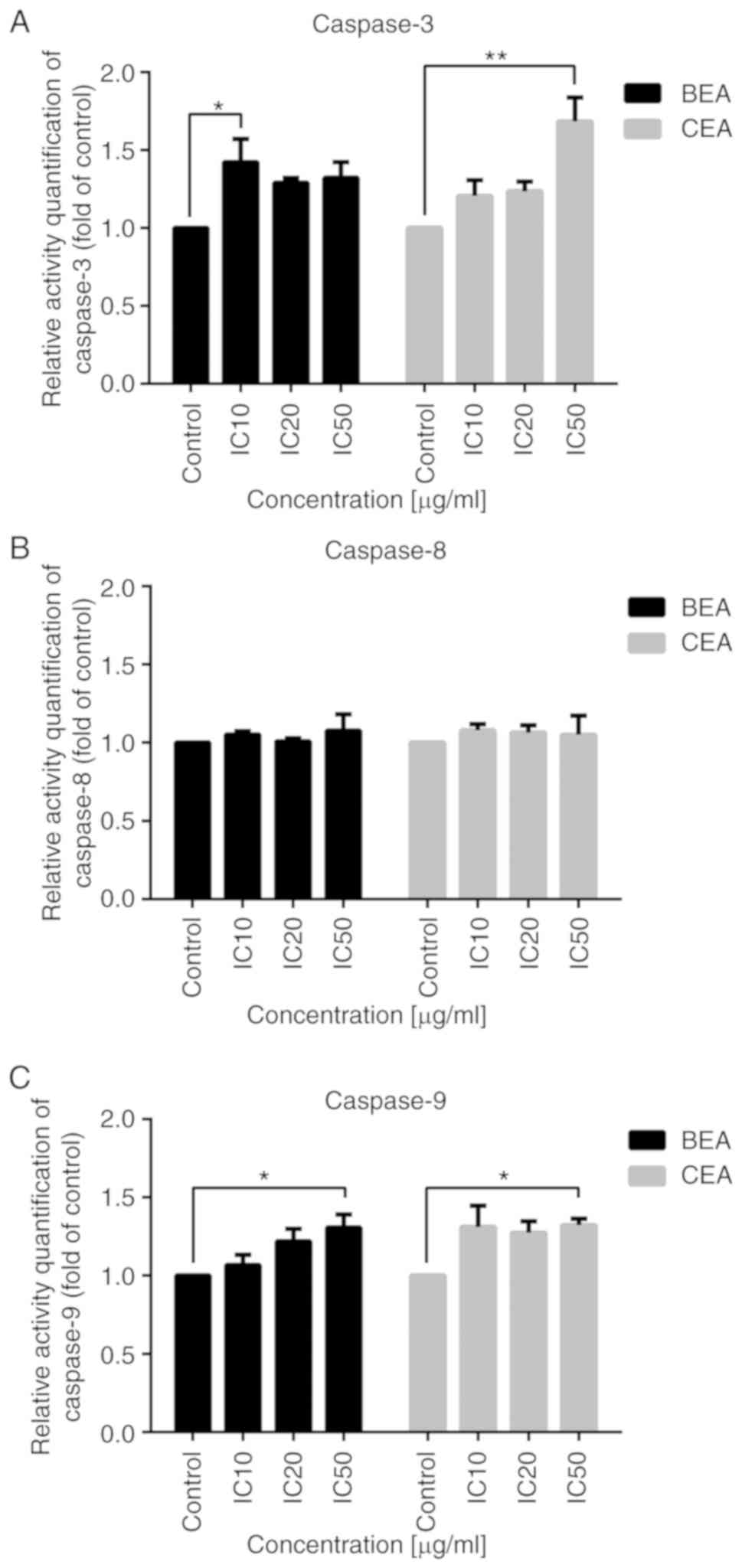Extracts of Bridelia ovata and Croton oblongifolius induce apoptosis in human MDA‑MB‑231 breast cancer cells via oxidative stress and mitochondrial pathways
- Authors:
- Juthathip Poofery
- Bungorn Sripanidkulchai
- Ratana Banjerdpongchai
-
Affiliations: Department of Biochemistry, Faculty of Medicine, Chiang Mai University, Chiang Mai 50200, Thailand, Center for Research and Development of Herbal Health Products, Faculty of Pharmaceutical Sciences, Khon Kaen University, Khon Kaen 40002, Thailand - Published online on: January 31, 2020 https://doi.org/10.3892/ijo.2020.4973
- Pages: 969-985
This article is mentioned in:
Abstract
 |
 |
 |
 |
 |
 |
 |
 |
 |
 |
|
DeSantis CE, Ma J, Goding Sauer A, Newman LA and Jemal A: Breast cancer statistics, 2017, racial disparity in mortality by state. CA Cancer J Clin. 67:439–448. 2017. View Article : Google Scholar : PubMed/NCBI | |
|
Jemal A, Bray F, Center MM, Ferlay J, Ward E and Forman D: Global cancer statistics. CA Cancer J Clin. 61:69–90. 2011. View Article : Google Scholar : PubMed/NCBI | |
|
Sledge GW, Mamounas EP, Hortobagyi GN, Burstein HJ, Goodwin PJ and Wolff AC: Past, present, and future challenges in breast cancer treatment. J Clin Oncol. 32:1979–1986. 2014. View Article : Google Scholar : PubMed/NCBI | |
|
Moiseenko F, Volkov N, Bogdanov A, Dubina M and Moiseyenko V: Resistance mechanisms to drug therapy in breast cancer and other solid tumors: An opinion. F1000Res. 6:2882017. View Article : Google Scholar : PubMed/NCBI | |
|
Liu W, Fu X, Yang Z, Li S, Cao Y, Li Q and Luan J: Moderate intermittent negative pressure increases invasiveness of MDA-MB-231 triple negative breast cancer cells. Breast. 38:14–21. 2018. View Article : Google Scholar | |
|
Sun L, Legood R, Dos-Santos-Silva I, Gaiha SM and Sadique Z: Global treatment costs of breast cancer by stage: A systematic review. PLoS One. 13:e02079932018. View Article : Google Scholar : PubMed/NCBI | |
|
Chotchoungchatchai S, Saralamp P, Jenjittikul T, Pornsiripongse S and Prathanturarug S: Medicinal plants used with thai traditional medicine in modern healthcare services: A case study in Kabchoeng Hospital, Surin Province, Thailand. J Ethnopharmacol. 141:193–205. 2012. View Article : Google Scholar : PubMed/NCBI | |
|
Boonyaratavej S, Tantayanontha S, Kitchanachai P, Chaichantipyuth C, Chittawong V and Miles DH: Trans-triacontyl-4-hydroxy-3-methoxycinnamate, a new compound from the thai plant bridelia ovata. J Nat Prod. 55:1761–1763. 1992. View Article : Google Scholar | |
|
Thongkorn N: Chemical constituents of the leaves of bridelia ovata decne (unpublished PhD thesis). Chulalongkorn University; 1995 | |
|
Baig H, Diskul-Na-Ayudthaya P, Weeraphan C, Paricharttanakul M, Svasti J and Srisomsap C: Inhibitory effect of bridelia ovata decne extract on HepG2 cell migration and invasion stimulated by fibroblast-conditioned media. Naresuan Phayao J. 1:6–10. 2015. | |
|
Sommit D, Petsom A, Ishikawa T and Roengsumran S: Cytotoxic activity of natural labdanes and their semi-synthetic modified derivatives from Croton oblongifolius. Planta Med. 69:167–170. 2003. View Article : Google Scholar : PubMed/NCBI | |
|
Ngamrojnavanich N, Sirimongkon S, Roengsumran S, Petsom A and Kamimura H: Inhibition of Na+,K+-ATPase activity by (-)-ent-Kaur-16-en-19-oic acid and its derivatives. Planta Med. 69:555–556. 2003. View Article : Google Scholar : PubMed/NCBI | |
|
Ahmed B, Alam T, Varshney M and Khan SA: Hepatoprotective activity of two plants belonging to the Apiaceae and the euphor-biaceae family. J Ethnopharmacol. 79:313–316. 2002. View Article : Google Scholar : PubMed/NCBI | |
|
Salatino A, Salatino MLF and Negri G: Traditional uses, chemistry and pharmacology of Croton species (Euphorbiaceae). J Braz Chem Soc. 18:11–33. 2007. View Article : Google Scholar | |
|
Singh M, Pal M and Sharma RP: Biological activity of the labdane diterpenes. Planta Med. 65:2–8. 1999. View Article : Google Scholar : PubMed/NCBI | |
|
Takeshige Y, Kawakami S, Matsunami K, Otsuka H, Lhieochaiphant D and Lhieochaiphant S: Oblongionosides A-F, megastigmane glycosides from the leaves of Croton oblongifolius Roxburgh. Phytochemistry. 80:132–136. 2012. View Article : Google Scholar : PubMed/NCBI | |
|
Roengsumran S, Petsom A, Kuptiyanuwat N, Vilaivan T, Ngamrojnavanich N, Chaichantipyuth C and Phuthong S: Cytotoxic labdane diterpenoids from Croton oblongifolius. Phytochemistry. 56:103–107. 2001. View Article : Google Scholar : PubMed/NCBI | |
|
Pudhom K and Sommit D: Clerodane diterpenoids and a trisubstituted furan from Croton oblongifolius. Phytochem Lett. 4:147–150. 2011. View Article : Google Scholar | |
|
Roengsumran S, Musikul K, Petsom A, Vilaivan T, Sangvanich P, Pornpakakul S, Puthong S, Chaichantipyuth C, Jaiboon N and Chaichit N: Croblongifolin, a new anticancer clerodane from Croton oblongifolius. Planta Med. 68:274–277. 2002. View Article : Google Scholar : PubMed/NCBI | |
|
Youngsa-ad W, Ngamrojanavanich N, Mahidol C, Ruchirawat S, Prawat H and Kittakoop P: Diterpenoids from the roots of Croton oblongifolius. Planta Med. 73:1491–1494. 2007. View Article : Google Scholar : PubMed/NCBI | |
|
Pudhom K, Vilaivan T, Ngamrojanavanich N, Dechangvipart S, Sommit D, Petsom A and Roengsumran S: Furanocembranoids from the stem bark of Croton oblongifolius. J Nat Prod. 70:659–661. 2007. View Article : Google Scholar : PubMed/NCBI | |
|
Roengsumran S, Pornpakakul S, Muangsin N, Sangvanich P, Nhujak T, Singtothong P, Chaichit N, Puthong S and Petsom A: New halimane diterpenoids from Croton oblongifolius. Planta Med. 70:87–89. 2004. View Article : Google Scholar : PubMed/NCBI | |
|
Roengsumran S, Achayindee S, Petsom A, Pudhom K, Singtothong P, Surachetapan C and Vilaivan T: Two new cembranoids from Croton oblongifolius. J Nat Prod. 61:652–654. 1998. View Article : Google Scholar : PubMed/NCBI | |
|
Roengsumran S, Singtothong P, Pudhom K, Ngamrochanavanich N, Petsom A and Chaichantipyuth C: Neocrotocembranal from Croton oblongifolius. J Nat Prod. 62:1163–1164. 1999. View Article : Google Scholar : PubMed/NCBI | |
|
Suwancharoen S, Tommeurd W, Phurat C, Muangsin N and Pornpakakul S: Acanthoic acid. Acta Crystallogr Sect E Struct Rep Online. 66:o15312010. View Article : Google Scholar : PubMed/NCBI | |
|
Renehan AG, Booth C and Potten CS: What is apoptosis, and why is it important? BMJ. 322:1536–1538. 2001. View Article : Google Scholar : PubMed/NCBI | |
|
Favaloro B, Allocati N, Graziano V, Di Ilio C and De Laurenzi V: Role of apoptosis in disease. Aging (Albany N Y). 4:330–349. 2012. | |
|
Fathi N, Rashidi G, Khodadadi A, Shahi S and Sharifi S: STAT3 and apoptosis challenges in cancer. Int J Biol Macromol. 117:993–1001. 2018. View Article : Google Scholar : PubMed/NCBI | |
|
Kumar R, Herbert PE and Warrens AN: An introduction to death receptors in apoptosis. Int J Surg. 3:268–277. 2005. View Article : Google Scholar | |
|
O'Brien MA and Kirby R: Apoptosis: A review of pro-apoptotic and anti-apoptotic pathways and dysregulation in disease. J Veterinary Emergency Crit Care. 18:572–585. 2008. View Article : Google Scholar | |
|
Schneider P and Tschopp J: Apoptosis induced by death receptors. Pharm Acta Helv. 74:281–286. 2000. View Article : Google Scholar : PubMed/NCBI | |
|
Chinnaiyan AM: The apoptosome: Heart and soul of the cell death machine. Neoplasia. 1:5–15. 1999. View Article : Google Scholar | |
|
Tait SW and Green DR: Mitochondria and cell death: Outer membrane permeabilization and beyond. Nat Rev Mol Cell Biol. 11:621–632. 2010. View Article : Google Scholar : PubMed/NCBI | |
|
Cao K and Tait SWG: Apoptosis and cancer: Force awakens, phantom menace, or both? Int Rev Cell Mol Biol. 337:135–152. 2018. View Article : Google Scholar : PubMed/NCBI | |
|
Dong N, Liu X, Zhao T, Wang L, Li H, Zhang S, Li X, Bai X, Zhang Y and Yang B: Apoptosis-inducing effects and growth inhibitory of a novel chalcone, in human hepatic cancer cells and lung cancer cells. Biomed Pharmacother. 105:195–203. 2018. View Article : Google Scholar : PubMed/NCBI | |
|
Neve RM, Chin K, Fridlyand J, Yeh J, Baehner FL, Fevr T, Clark L, Bayani N, Coppe JP, Tong F, et al: A collection of breast cancer cell lines for the study of functionally distinct cancer subtypes. Cancer Cell. 10:515–527. 2006. View Article : Google Scholar : PubMed/NCBI | |
|
Dai X, Cheng H, Bai Z and Li J: Breast cancer cell line classification and its relevance with breast tumor subtyping. J Cancer. 8:3131–3141. 2017. View Article : Google Scholar : PubMed/NCBI | |
|
Chen X and Thibeault S: Effect of DMSO concentration, cell density and needle gauge on the viability of cryopreserved cells in three dimensional hyaluronan hydrogel. Conf Proc IEEE Eng Med Biol Soc. 2013:6228–6231. 2013.PubMed/NCBI | |
|
Arega ED: Phytochemical studies of the ethyl acetate extract of the fruit of piper capense. J Pharm Nat Products. 4:148–152. 2018. | |
|
Obasi NL, Egbuonu ACC, Ukoha PO and Ejikeme PM: Comparative phytochemical and antimicrobial screening of some solvent extracts of Samanea saman (fabaceae or mimosaceae) pods. Afr J Pure Appl Chem. 4:206–212. 2010. | |
|
Tiwari P, Kumar B, Kaur M, Kaur G and Kaur H: Phytochemical screening and extraction: A review. Int Pharm Sci. 1:98–106. 2011. | |
|
Banjerdpongchai R, Yingyurn S and Kongtawelert P: Sesamin induces human leukemic cell apoptosis via mitochondrial and endoplasmic reticulum stress pathways. World J Oncol. 1:78–86. 2010.PubMed/NCBI | |
|
Wudtiwai B, Sripanidkulchai B, Kongtawelert P and Banjerdpongchai R: Methoxyflavone derivatives modulate the effect of TRAIL-induced apoptosis in human leukemic cell lines. J Hematol Oncol. 4:522011. View Article : Google Scholar : PubMed/NCBI | |
|
Khaw-on P and Banjerdpongchai R: Induction of intrinsic and extrinsic apoptosis pathways in the human leukemic MOLT-4 cell line by terpinen-4-ol. Asian Pac J Cancer Prev. 13:3073–3076. 2012. View Article : Google Scholar : PubMed/NCBI | |
|
Khaw-On P, Pompimon W and Banjerdpongchai R: Goniothalamin induces necroptosis and anoikis in human invasive breast cancer MDA-MB-231 cells. Int J Mol Sci. 20:E39532019. View Article : Google Scholar : PubMed/NCBI | |
|
Dikalov S, Griendling KK and Harrison DG: Measurement of reactive oxygen species in cardiovascular studies. Hypertension. 49:717–727. 2007. View Article : Google Scholar : PubMed/NCBI | |
|
Zhao H, Kalivendi S, Zhang H, Joseph J, Nithipatikom K, Vasquez-Vivar J and Kalyanaraman B: Superoxide reacts with hydroethidine but forms a fluorescent product that is distinctly different from ethidium: Potential implications in intracellular fluorescence detection of superoxide. Free Radic Biol Med. 34:1359–1368. 2003. View Article : Google Scholar : PubMed/NCBI | |
|
Livak KJ and Schmittgen TD: Analysis of relative gene expression data using real-time quantitative PCR and the 2(-Delta Delta C(T)) method. Methods. 25:402–408. 2001. View Article : Google Scholar | |
|
Mitas M, Mikhitarian K, Walters C, Baron PL, Elliott BM, Brothers TE, Robison JG, Metcalf JS, Palesch YY, Zhang Z, et al: Quantitative real-time RT-PCR detection of breast cancer micrometastasis using a multigene marker panel. Int J Cancer. 93:162–171. 2001. View Article : Google Scholar : PubMed/NCBI | |
|
Hanf A, Oelze M, Manea A, Li H, Munzel T and Daiber A: The anti-cancer drug doxorubicin induces substantial epigenetic changes in cultured cardiomyocytes. Chem Biol Interact. 313:1088342019. View Article : Google Scholar : PubMed/NCBI | |
|
Wudtiwai B, Pitchakarn P and Banjerdpongchai R: Alpha-mangostin, an active compound in Garcinia mangostana, abrogates anoikis-resistance in human hepatocellular carcinoma cells. Toxicol In Vitro. 53:222–232. 2018. View Article : Google Scholar : PubMed/NCBI | |
|
Badisa RB, Darling-Reed SF, Joseph P, Cooperwood JS, Latinwo LM and Goodman CB: Selective cytotoxic activities of two novel synthetic drugs on human breast carcinoma MCF-7 cells. Anticancer Res. 29:2993–2996. 2009.PubMed/NCBI | |
|
Prayong P, Barusrux S and Weerapreeyakul N: Cytotoxic activity screening of some indigenous Thai plants. Fitoterapia. 79:598–601. 2008. View Article : Google Scholar : PubMed/NCBI | |
|
Rivankar S: An overview of doxorubicin formulations in cancer therapy. J Cancer Res Ther. 10:853–858. 2014. View Article : Google Scholar | |
|
Kalogeris T, Bao Y and Korthuis RJ: Mitochondrial reactive oxygen species: A double edged sword in ischemia/reperfusion vs. preconditioning Redox Biol. 2:702–714. 2014. View Article : Google Scholar | |
|
Kalyanaraman B, Darley-Usmar V, Davies KJ, Dennery PA, Forman HJ, Grisham MB, Mann GE, Moore K, Roberts LJ II and Ischiropoulos H: Measuring reactive oxygen and nitrogen species with fluorescent probes: Challenges and limitations. Free Radic Biol Med. 52:1–6. 2012. View Article : Google Scholar | |
|
Tsujimoto Y: Role of Bcl-2 family proteins in apoptosis: Apoptosomes or mitochondria? Genes Cells. 3:697–707. 1998. View Article : Google Scholar | |
|
Sousa GFd, Soares DCF, Mussel WdN, Pompeu NFE, Silva GDdF, Vieira Filho SA and Duarte LP: Pentacyclic triterpenes from branches of Maytenus robusta and in vitro cytotoxic property against. J Braz Chem Soc. 25:1338–1345. 2014. | |
|
Martucciello S, Balestrieri ML, Felice F, Estevam Cdos S, Sant'Ana AE, Pizza C and Piacente S: Effects of triterpene derivatives from Maytenus rigida on VEGF-induced Kaposi's sarcoma cell proliferation. Chem Biol Interact. 183:450–454. 2010. View Article : Google Scholar | |
|
Balbinot RB, de Oliveira JAM, Bernardi DI, Melo UZ, Zanqueta EB, Endo EH, Ribeiro FM, Volpato H, Figueiredo MC, Back DF, et al: Structural characterization and biological evaluation of 18-Nor-ent-labdane diterpenoids from grazielia gaudichaudeana. Chem Biodivers. 16:e18006442019. View Article : Google Scholar : PubMed/NCBI | |
|
Cavalcanti BC, Ferreira JR, Moura DJ, Rosa RM, Furtado GV, Burbano RR, Silveira ER, Lima MA, Camara CA, Saffi J, et al: Structure-mutagenicity relationship of kaurenoic acid from Xylopia sericeae (Annonaceae). Mutat Res. 701:153–163. 2010. View Article : Google Scholar : PubMed/NCBI | |
|
Cavalcanti BC, Bezerra Dp, Magalhaes HI, Moraes MO, Lima MA, Silveira ER, Camara CA, Rao VS, Pessoa C and Costa-Lotufo LV: Kauren-19-oic acid induces DNA damage followed by apoptosis in human leukemia cells. J Appl Toxicol. 29:560–568. 2009. View Article : Google Scholar : PubMed/NCBI | |
|
Cuca LE, Coy ED, Alarcon MA, Fernandez A and Aristizabal FA: Cytotoxic effect of some natural compounds isolated from Lauraceae plants and synthetic derivatives. Biomedica. 31:335–343. 2011. View Article : Google Scholar | |
|
Cardoso PCDS, Rocha CAMD, Leal MF, Bahia MO, Alcantara DDFA, Santos RAD, Gongalves NDS, Ambrosio SR, Cavalcanti BC, Moreira-Nunes CA, et al: Effect of diterpenoid kaurenoic acid on genotoxicity and cell cycle progression in gastric cancer cell lines. Biomed Pharmacother. 89:772–780. 2017. View Article : Google Scholar : PubMed/NCBI | |
|
Rocha SMMD, Cardoso PCDS, Bahia MO, Pessoa CDO, Soares PC, Rocha SMD, Burbano RMR and Rocha CAMD: Effect of the kaurenoic acid on genotoxicity and cell cycle progression in cervical cancer cells lines. Toxicol In Vitro. 57:126–131. 2019. View Article : Google Scholar : PubMed/NCBI | |
|
Fernandes VC, Pereira SI, Coppede J, Martins JS, Rizo WF, Beleboni RO, Marins M, Pereira PS, Pereira AM and Fachin AL: The epimer of kaurenoic acid from Croton antisyphiliticus is cytotoxic toward B-16 and HeLa tumor cells through apoptosis induction. Genet Mol Res. 12:1005–1011. 2013. View Article : Google Scholar : PubMed/NCBI | |
|
Fernando IPS, Sanjeewa KKA, Ann YS, Ko CI, Lee SH, Lee WW and Jeon YJ: Apoptotic and antiproliferative effects of Stigmast-5-en-3-ol from Dendronephthya gigantea on human leukemia HL-60 and human breast cancer MCF-7 cells. Toxicol In Vitro. 52:297–305. 2018. View Article : Google Scholar : PubMed/NCBI | |
|
Jian B, Zhang H, Han C and Liu J: Anti-cancer activities of diterpenoids derived from Euphorbia fischeriana steud. Molecules. 23:E3872018. View Article : Google Scholar : PubMed/NCBI | |
|
Petiwala SM and Johnson JJ: Diterpenes from rosemary (Rosmarinus officinalis): Defining their potential for anti-cancer activity. Cancer Lett. 367:93–102. 2015. View Article : Google Scholar : PubMed/NCBI | |
|
Suttiarporn P, Chumpolsri W, Mahatheeranont S, Luangkamin S, Teepsawang S and Leardkamolkarn V: Structures of phytosterols and triterpenoids with potential anti-cancer activity in bran of black non-glutinous rice. Nutrients. 7:1672–1687. 2015. View Article : Google Scholar : PubMed/NCBI | |
|
Saleem M: Lupeol, a novel anti-inflammatory and anti-cancer dietary triterpene. Cancer Lett. 285:109–115. 2009. View Article : Google Scholar : PubMed/NCBI | |
|
Weerapreeyakul N, Nonpunya A, Barusrux S, Thitimetharoch T and Sripanidkulchai B: Evaluation of the anticancer potential of six herbs against a hepatoma cell line. Chin Med. 7:152012. View Article : Google Scholar : PubMed/NCBI | |
|
Sinha K, Das J, Pal PB and Sil PC: Oxidative stress: The mitochondria-dependent and mitochondria-independent pathways of apoptosis. Arch Toxicol. 87:1157–1180. 2013. View Article : Google Scholar : PubMed/NCBI | |
|
Cairns RA, Harris IS and Mak TW: Regulation of cancer cell metabolism. Nat Rev Cancer. 11:85–95. 2011. View Article : Google Scholar : PubMed/NCBI | |
|
Circu ML and Aw TY: Reactive oxygen species, cellular redox systems, and apoptosis. Free Radic Biol Med. 48:749–762. 2010. View Article : Google Scholar : PubMed/NCBI | |
|
Redza-Dutordoir M and Averill-Bates DA: Activation of apoptosis signalling pathways by reactive oxygen species. Biochim Biophys Acta. 1863:2977–2992. 2016. View Article : Google Scholar : PubMed/NCBI | |
|
He H, Zang LH, Feng YS, Chen LX, Kang N, Tashiro S, Onodera S, Qiu F and Ikejima T: Physalin A induces apoptosis via p53-Noxa-mediated ROS generation, and autophagy plays a protective role against apoptosis through p38-NF-kB survival pathway in A375-S2 cells. J Ethnopharmacol. 148:544–555. 2013. View Article : Google Scholar : PubMed/NCBI | |
|
Yu CC, Ko FY, Yu CS, Lin CC, Huang YP, Yang JS, Lin JP and Chung JG: Norcantharidin triggers cell death and DNA damage through S-phase arrest and ROS-modulated apoptotic pathways in TSGH 8301 human urinary bladder carcinoma cells. Int J Oncol. 41:1050–1060. 2012. View Article : Google Scholar : PubMed/NCBI | |
|
Weinberg F, Ramnath N and Nagrath D: Reactive oxygen species in the tumor microenvironment: An overview. Cancers (Basel). 11:E11912019. View Article : Google Scholar | |
|
Crompton M: The mitochondrial permeability transition pore and its role in cell death. Biochem J. 341:233–249. 1999. View Article : Google Scholar : PubMed/NCBI | |
|
Griffith OW: Biologic and pharmacologic regulation of mammalian glutathione synthesis. Free Radic Biol Med. 27:922–935. 1999. View Article : Google Scholar : PubMed/NCBI | |
|
Komonrit P and Banjerdpongchai R: Effect of Pseuderanthemum palatiferum (Nees) radlk fresh leaf ethanolic extract on human breast cancer MDA-MB-231 regulated cell death. Tumour Biol. 40:10104283188001822018. View Article : Google Scholar : PubMed/NCBI | |
|
Kumari S, Badana AK, GMM GS and Malla R: Reactive oxygen species: A key constituent in cancer survival. Biomark Insights. 13:11772719187553912018. View Article : Google Scholar : PubMed/NCBI | |
|
Kastenhuber ER and Lowe SW: Putting p53 in context. Cell. 170:1062–1078. 2017. View Article : Google Scholar : PubMed/NCBI | |
|
Vousden KH and Lu X: Live or let die: The cell's response to p53. Nat Rev Cancer. 2:594–604. 2002. View Article : Google Scholar : PubMed/NCBI | |
|
Lowe SW, Ruley HE, Jacks T and Housman DE: p53-dependent apoptosis modulates the cytotoxicity of anticancer agents. Cell. 74:957–967. 1993. View Article : Google Scholar : PubMed/NCBI | |
|
Shibue T, Suzuki S, Okamoto H, Yoshida H, Ohba Y, Takaoka A and Taniguchi T: Differential contribution of Puma and Noxa in dual regulation of p53-mediated apoptotic pathways. EMBO J. 25:4952–4962. 2006. View Article : Google Scholar : PubMed/NCBI | |
|
Shibue T, Takeda K, Oda E, Tanaka H, Murasawa H, Takaoka A, Morishita Y, Akira S, Taniguchi T and Tanaka N: Integral role of Noxa in p53-mediated apoptotic response. Genes Dev. 17:2233–2238. 2003. View Article : Google Scholar : PubMed/NCBI | |
|
Zhang LN, Li JY and Xu W: A review of the role of Puma, Noxa and Bim in the tumorigenesis, therapy and drug resistance of chronic lymphocytic leukemia. Cancer Gene Ther. 20:1–7. 2013. View Article : Google Scholar | |
|
McIlwain DR, Berger T and Mak TW: Caspase functions in cell death and disease. Cold Spring Harb Perspect Biol. 5:a0086562013. View Article : Google Scholar : PubMed/NCBI | |
|
Saraste A and Pulkki K: Morphologic and biochemical hallmarks of apoptosis. Cardiovasc Res. 45:528–537. 2000. View Article : Google Scholar : PubMed/NCBI | |
|
Huttemann M, Pecina P, Rainbolt M, Sanderson TH, Kagan VE, Samavati L, Doan JW and Lee I: The multiple functions of cytochrome c and their regulation in life and death decisions of the mammalian cell: From respiration to apoptosis. Mitochondrion. 11:369–381. 2011. View Article : Google Scholar : PubMed/NCBI | |
|
Salvesen GS: Caspases and apoptosis. Essays Biochem. 38:9–19. 2002. View Article : Google Scholar : PubMed/NCBI |










